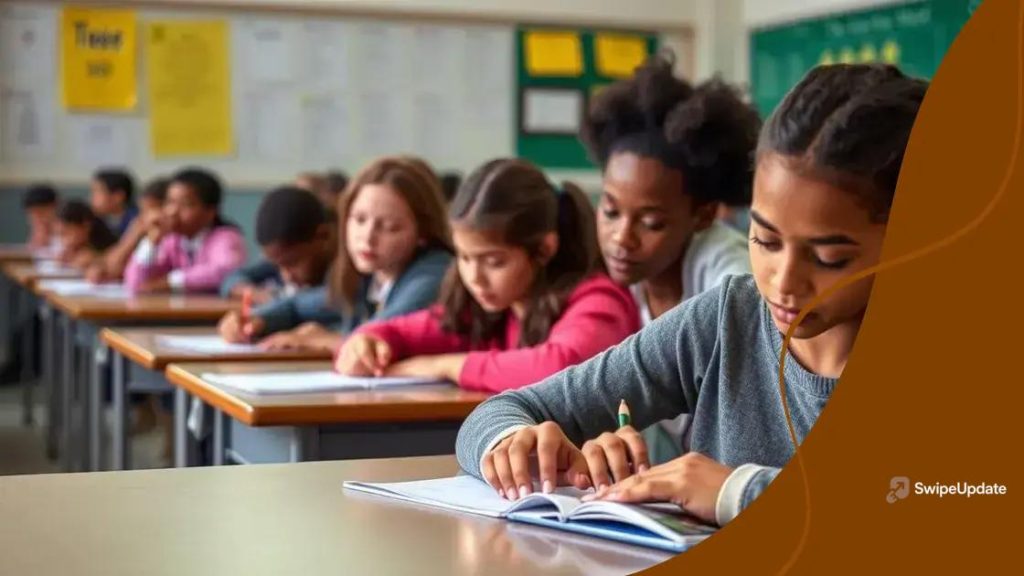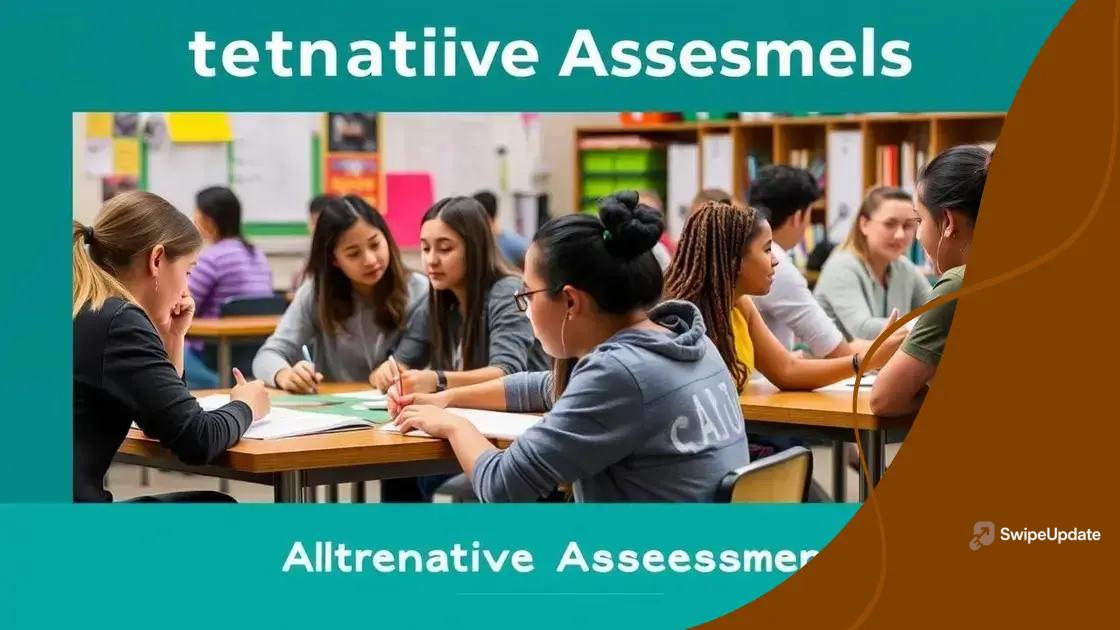What the future holds for standardized testing

Future trends in educational evaluation focus on personalized assessments, skills-based evaluations, and technology integration, enhancing data-driven insights and fostering continuous improvement in student learning.
What the future holds for standardized testing is a question on many educators’ minds. As we navigate changes in learning environments, it’s intriguing to consider how these assessments will adapt and what that means for students and institutions.
The evolution of standardized testing
The evolution of standardized testing has shaped the educational landscape over many decades. Initially designed to provide a uniform way to measure student learning, these tests have transitioned significantly, reflecting changes in educational philosophy and technology.
Today, we see a mix of traditional methods and innovative approaches. For instance, many educators are advocating for assessments that go beyond mere testing. Let’s explore a few key aspects of this evolution.
Changes in Testing Formats
The structure of standardized tests has evolved dramatically. Originally, these tests relied heavily on multiple-choice questions. Now, however, they increasingly integrate:
- Performance tasks that assess critical thinking
- Project-based assessments to evaluate real-world skills
- Online testing formats that provide immediate feedback
- Adaptive testing that adjusts difficulty based on student performance
These innovations enhance how we understand and measure student learning. Each change aims to create a more comprehensive view that moves beyond rote memorization.
Moreover, technology plays a vital role in this evolution. With the rise of educational technologies, teachers now have greater tools at their disposal for assessment. Through various platforms, educators can gather data that informs instruction and supports individualized learning paths.
Shifts in Educational Philosophy
The philosophy around standardized testing has also undergone significant changes. No longer viewed as the only measure of student capability, these assessments are now seen as one part of a broader evaluation system. The idea is to recognize that intelligence and potential are multi-faceted.
For instance, some educational leaders now focus on:
- Emphasizing social and emotional learning
- Encouraging creativity and innovation in assessments
- Utilizing formative assessments that guide ongoing learning
This shift reflects a deeper understanding of how diverse learning styles and backgrounds impact student performance. The goal is to create equitable assessment environments that recognize and value individual strengths.
In conclusion, the evolution of standardized testing is marked by enhanced formats, technological advancements, and shifts in educational philosophy. These changes aim to create a more nuanced understanding of student learning that better prepares them for future challenges.
Impact of technology on testing methods
The impact of technology on testing methods has been transformative. As educational technology evolves, it revolutionizes the way assessments are designed and delivered. Today, students often engage with interactive testing formats that make the process more engaging and relevant to their learning.
Online assessments have become a common practice. These platforms allow for immediate feedback, which enhances the learning experience. Students can receive results right after completing a test, helping them understand their strengths and areas for improvement much quicker than with traditional paper tests.
Benefits of Technology in Testing
With the integration of technology, several benefits emerge:
- Increased accessibility for diverse learners
- Reduction in administrative burdens for educators
- Flexibility in testing locations and schedules
- Enhanced data collection and analysis capabilities
This shift enables educators to gather meaningful insights and adjust instructional strategies accordingly. Additionally, students can often choose their preferred testing times, accommodating their individual needs.
Furthermore, adaptive testing technology tailors assessments to match each student’s level of understanding. As a result, questions modify in real-time, offering a personalized experience that should lead to a more accurate assessment of knowledge and skills.
Challenges Presented by Technology
However, the integration of technology is not without its challenges. One major concern is ensuring equity in access to technology. Students from lower socio-economic backgrounds might struggle with access to the necessary devices or internet connection. This gap can lead to unequal testing environments.
Another challenge is the security and integrity of online assessments. Educators and administrators must be vigilant about enforcing measures to prevent cheating and ensure that the results reflect genuine student understanding. As technology progresses, finding effective solutions to these challenges will be crucial.
The continuous evolution of technology will surely influence testing methods further. This ongoing change underscores the importance of adapting education systems to meet the demands of an increasingly digital world.
Alternative assessments gaining popularity

Alternative assessments are gaining popularity as educators seek more effective ways to evaluate student learning. These methods move beyond traditional standardized tests, providing a richer picture of a student’s abilities. By focusing on real-world skills and knowledge application, alternative assessments can better reflect what students know and can do.
One popular form of alternative assessment is project-based learning. In this approach, students engage in complex projects that require critical thinking, collaboration, and creativity. This method allows students to showcase their learning in a more comprehensive way. Additionally, teachers can assess students based on their process and final product.
Types of Alternative Assessments
There are various types of alternative assessments that have emerged:
- Portfolios: Collections of student work over time that demonstrate their progress and skill development.
- Self-assessments: Tools allowing students to reflect on their learning and set personal goals.
- Peer assessments: Opportunities for students to evaluate each other’s work and provide constructive feedback.
- Performance tasks: Activities requiring students to apply their knowledge to real-world scenarios.
These assessments encourage student engagement and ownership of learning, which can lead to deeper understanding and retention of concepts.
Moreover, alternative assessments help teachers understand the diverse strengths and weaknesses of their students. By using varied approaches, teachers can tailor instruction to meet individual needs. This flexibility allows for a more inclusive learning environment, where all students can succeed.
Benefits of Alternative Assessments
The benefits of implementing alternative assessments are significant. They promote critical thinking and problem-solving skills, essential for success in today’s world. These assessments also foster creativity, allowing students to express their understanding in unique ways. Furthermore, they can help reduce test anxiety that some students feel during traditional exams.
As alternative assessments gain traction, educators are increasingly recognizing their value. By incorporating these methods into the curriculum, schools can prepare students for future challenges, equipping them with the skills they need to thrive.
Challenges and criticisms of standardized testing
The challenges and criticisms of standardized testing have become increasingly prominent in education discussions. Many educators, students, and parents voice their concerns about the limitations and implications of these tests. Understanding these issues is key to fostering a better educational environment.
One significant challenge is the potential for bias in testing. Critics argue that standardized tests may not accurately measure the abilities of all students, particularly those from diverse backgrounds. Cultural differences and language barriers can affect performance, raising questions about fairness.
Impact on Curriculum and Instruction
Another concern is how standardized testing influences curriculum and instruction. Schools often feel pressured to teach to the test, focusing primarily on test preparation rather than holistic learning. This can lead to:
- A narrowed curriculum, excluding important but non-tested subjects like art and music.
- Increased stress and anxiety for students as they prepare for high-stakes exams.
- Less emphasis on critical thinking and creativity in favor of rote memorization.
- Teachers feeling constrained in their teaching methods, impacting their ability to engage students.
The consequences of these pressures can diminish the quality of education, ultimately leaving students less prepared for real-world challenges.
Moreover, critics frequently point to the over-reliance on test results for making high-stakes decisions, such as student promotion and teacher evaluations. This practice can create a high-pressure environment that may not accurately reflect a student’s knowledge or a teacher’s effectiveness. Test scores, while informative, often fail to capture the full picture of student learning.
Equity Issues
Equity is another pressing issue surrounding standardized testing. Research indicates that students from lower socio-economic backgrounds may not have access to the resources needed to perform well. Tutoring, test preparation courses, and even a quiet place to study are often unavailable to these students, resulting in a performance gap.
This raises ethical questions about the validity of using standardized tests as a primary indicator of student potential. Many argue that alternative assessments should be considered to create a more equitable assessment landscape that values diverse skills and experiences.
In conclusion, while standardized testing plays a role in measuring educational outcomes, the challenges and criticisms surrounding these assessments underscore the need for a more balanced and inclusive approach. By addressing these concerns, educators can work toward creating a fairer system that truly reflects student learning and potential.
Future trends in educational evaluation
Future trends in educational evaluation are set to reshape how we assess student learning. As technology and educational practices evolve, so too do the methods employed to evaluate students. These innovations aim to provide a more comprehensive understanding of student progress and abilities.
One significant trend is the increased use of data analytics. Schools are beginning to rely on data-driven insights to inform their teaching strategies. By collecting and analyzing various data points—such as grades, attendance, and engagement levels—educators can create personalized learning experiences tailored to individual student needs.
Emphasis on Skills Assessment
Another growing focus is on assessing skills rather than merely content knowledge. Traditional tests often measure memorization, whereas future evaluations will prioritize:
- Critical thinking and problem-solving abilities.
- Collaboration and teamwork skills.
- Creativity in expressing ideas and concepts.
- Real-world application of knowledge in various situations.
This shift encourages a more holistic view of student learning, preparing them for life beyond school.
Furthermore, the integration of formative assessments will become more common. These assessments, which occur during the learning process, provide ongoing feedback to both teachers and students. This allows for immediate adjustments, fostering a growth mindset and a focus on improvement rather than just final grades.
Technology-Enhanced Assessments
Technology will also play a crucial role in future educational evaluations. With advancements in artificial intelligence and machine learning, assessments can become more adaptive and personalized. For instance, adaptive testing will enable questions to adjust in real-time based on student responses, creating a customized assessment experience.
Moreover, the use of online platforms for assessments enhances accessibility. Students can take tests in various settings, reducing anxiety associated with traditional testing environments. Instant feedback through digital solutions can motivate students to engage more deeply with the material.
Lastly, competency-based assessments are likely to gain traction. Instead of progressing solely based on time spent in class, students will advance upon demonstrating mastery of specific skills and knowledge. This approach aligns assessment more closely with individual learning paces and styles.
In summary, the future of educational evaluation is evolving to meet the diverse needs of students. As technology becomes more integrated into assessments, we will see a shift towards personalized and skills-focused evaluations. This means moving away from just memorizing facts to showcasing real skills and creativity. Additionally, data analytics will help educators make informed decisions that support every student’s learning journey. By embracing these changes, we can create a more effective and equitable education system that prepares students for success in their future.
FAQ – Frequently Asked Questions about Future Trends in Educational Evaluation
What are some future trends in educational evaluation?
Future trends include personalized assessments, skills-based evaluations, and the use of data analytics to support teaching strategies.
How will technology influence educational assessments?
Technology will allow for more adaptive testing methods, providing real-time feedback and enhancing accessibility for students.
What is the importance of formative assessments?
Formative assessments provide ongoing feedback that helps students improve continuously, rather than focusing solely on final grades.
How can schools ensure equity in assessments?
By utilizing multiple assessment methods and focusing on diverse skill sets, schools can create a fair assessment environment that accommodates all students.
